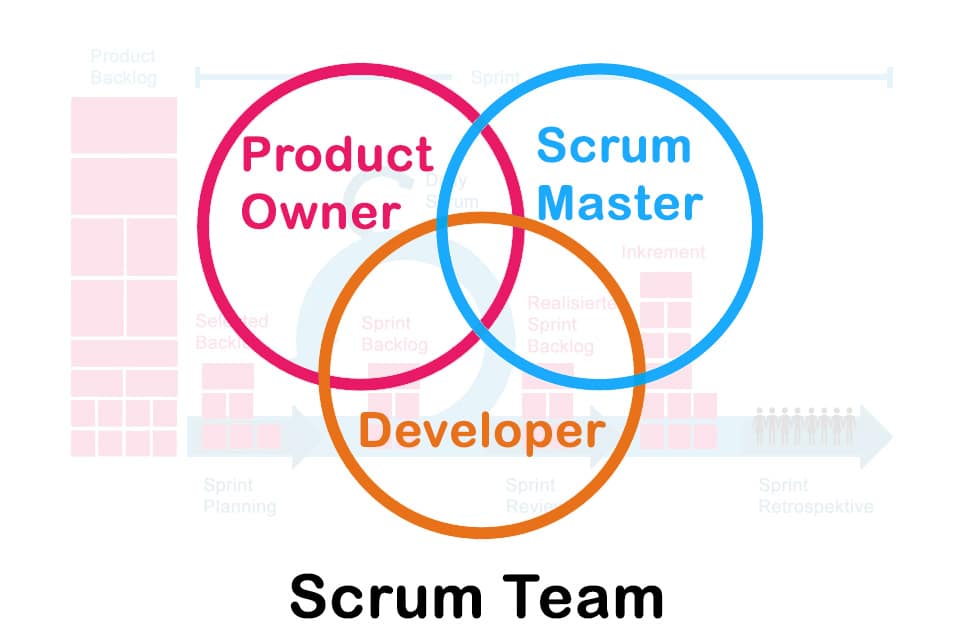What is a Scrum Team?
Smartpedia: The Scrum Team consists of Product Owner, Scrum Master and Developer. The Scrum Guide defines them as accountabilities.
Scrum Team – jointly accountable
Instead of roles, the current Scrum Guide defines so-called accountabilities¹ or responsibilities within a Scrum Team. The idea behind this is that every person who actively participates in a development or a project takes responsibility for
- specific areas,
- the implementation of tasks,
- the adherence to commitments,
- the culture of cooperation and
- the results!
And since this takes place in close cooperation, Scrum as a name also makes sense; the term comes from the sport of rugby and describes a situation in which a phase of the game is restarted on command.
Three accountabilities are defined within the Scrum Team: Product Owner, Scrum Master and Developers.
Product Owner – the representative of the stakeholders
The Product Owner is part of the Scrum Team and
- represents the ideas of the stakeholders,
- creates and maintains the Product Backlog,
- works closely with the developers, and
- is responsible for defining the product goal and in many organisations also for the success of the development.
He or she actively influences the development by formulating and prioritising backlog items (all of which, however, can also be recorded by colleagues). In practice, he/she is often responsible for releases and release plans, maintains a capacity plan and carries out risk management. He/she thus combines product and project management tasks.
Despite his/her responsibility and numerous tasks, he/she is not the supervisor of the Scrum Team. He/she should not get involved in technical solution discussions or the estimation of effort. In order for the product owner to be able to do his job well, he/she must be authorised by management to make decisions regarding requirements and functional scope, for example. In addition, it is important that the Product Owner is qualified in both technical and communication skills and that he or she is always available.
Scrum Master – the master of the framework
The Scrum Master is responsible for the implementation of Scrum. As a member of the team he/she acts as a moderator, mediator, process facilitator, supporter and coach. Put simply, he/she helps both Developers and the Product Owner to achieve goals together by facilitating the work of colleagues and encouraging collaboration.
The Scrum Master
- tries to create a trusting, open working atmosphere and
- to live the values of the framework.
- In doing so, he/she not only works in the direction of the Scrum Team, but also in the direction of the stakeholders and the organisation.
- And if necessary he/she addresses unproductive behaviour or offers appropriate feedback.
The activities of the Scrum Master should not be confused with those of a project manager. He/she has no authority to give instructions and therefore no power of decision. In Scrum the Developers organise or manage themselves. Within the Retrospective he/she gets the opportunity to ask for feedback on his/her own activities.
Developer – a collective term for active contributors
Besides the Product Owner and the Scrum Master, the Scrum Guide 2020 defines another accountability: the Developers. In the previous version of the guide there was still talk of a development team.
Developers are those in the Scrum Team who have committed themselves in a Sprint to create every aspect of an Increment. In practice, this means that from now on not only software developers, but all those involved – e.g. managers in the line, UX designers or marketing staff who are actively involved in a Sprint – may feel addressed.
Since the Scrum Team should consist of 10 or less people, a maximum of 8 developers should be involved in a team. Ideally they should work across functions and together have all the skills needed to create an Increment at the end of the Sprint. Regardless of the skills of the individual members, the framework does not define additional accountabilities, roles or titles for the team. Emphasis is placed on the shared responsibility to create a potentially deliverable increment. Basically, the developers manage themselves and neither Product Owner nor Scrum Master is superior to them.
Scrum Team in brief
To summarise: the Scrum Team
- is interdisciplinary, i.e. the members have the skills required to create value in each sprint. It functions as a unit of professionals who work together to achieve the defined Product Goal.
- does not know any sub-teams or hierarchies.
- usually comprises 10 or fewer people to enable communication among them and productive work. If more people are involved, it may make sense to divide the team into several Scrum Teams.
- is responsible for the implementation of all product-related activities, such as collaboration with stakeholders, specification, maintenance, operation, experimentation, etc.
- is accountable for results, i.e. in each Sprint a useful Increment has to be created.² A prerequisite for this is self-management.³
In short: the Scrum Team is the central component of Scrum!
Why does it happen time and again in practice that product managers are “renamed” Product Owners and project managers are “renamed” Scrum Masters?
Notes:
[1] Scrum Accountability
[2] See Scrum Guide and the original documentation respectively.
[3] Self-management as a prerequisite for accountability
If you read the term Scrum role in publications, then you know that it must be a somewhat older text, because since November 2020 role is no longer used as a term in the description of the framework.
If you like the article or would like to discuss it, please feel free to share it in your network. And if you have any comments, please do not hesitate to send us a message.
And here you will find additional information from the t2informatik Blog:




